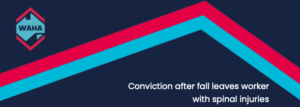
Article by Gordon Cadzow, Secretary of the WAHA.
Those designing buildings and structures have a responsibility to consider all aspects of safety over the life of the building or structure – during its construction, the maintenance requirements over its life cycle and even its eventual demolition. These requirements are clearly set out in “Safe Design of Structures’ Code of Practice (2014) issued by SafeWork NSW and other state regulators. In reality however, companies are dealing with both new and old structures – which means that the safe design principles will take some time to manifest in building design over the coming decades.
In the intervening period, where an assessment of a planned work activity indicates that there may be a health & safety risk to those undertaking the work, action must be taken to develop a safe work method. This is particularly relevant when work has to be undertaken at height – either to access the work area or where the work area itself is at height.
Where it has been identified that work may have to be carried on at height over the building life cycle, the hierarchy of control should be applied in order to determine if that need can be eliminated – by changes to design or “engineering out” the need to work at height.
If this is not possible, how then can the risks associated with working at height be minimised by utilising a Height safety system?
System Design
Where it has been identified that work will have to be carried out at height, the focus must initially be directed at the development of the safest possible work method. This is the task of the system designer who should be qualified to the level of Height Safety Manager as defined in AS/NZS1891.4 Section E3(e). The system developed will account for a variety of circumstances, such as frequency of use, the nature of the work being undertaken, the number of users accessing the system and their training competencies etc. Once the safe system is designed and deemed ‘reasonably practicable’ for the purpose, the design of a system can be documented, with details on how the system is designed to be used. Once formalised, this procedure will therefore effectively be the basis for preparing a Safe Work Method Statement (SWMS) – the template document for which can be filed in the Height Safety System File.
The system designer is also responsible for defining the specification of the type of equipment to be used and ensuring that the structure to which it is fixed is capable of sustaining the loads, should a fall from height occur. Again, these design details and calculations should be documented and added to the Height Safety System File.
System Installation
Those contracted to install the system must ensure that the system is installed exactly to the design requirements using the specified equipment. The installers undertaking the installation must be certified by the product manufacturer as accredited installers and copies of such installation certification should be added to the System File and available for review by the asset owner.
The system installer must ensure correct product installation and labelling and may be required to test and certify each component in line with the manufacturer’s instructions (e.g. for concrete mounted anchors, cable swaging tests etc). Any test certification details – along with the required date for re-certification should then be added to the system file. To enable future component inspection and re-certification, the manufacturer’s specific fixing instructions should also be added to the System File.
The system should now be available for safe use. However, it is often at this time that the actual building or structure is passed from the construction company to the owner / operator / facility manager. Where this transfer of responsibility happens, it is essential that the System File is transferred to the new asset manager at that time so a detailed record of these documents can be available for future re-certification of these systems to be undertaken.
System Users
System users are often specialist tradesmen (electricians, plumbers etc.) related to the task being undertaken. Where working at height is involved, the tradesmen must also hold a current Nationally Recognised certification for Safe Working at Height from an RTOP as a minimum requirement. One lead person should be certified to at least Height Safety Supervisor level as defined in AS/NZS1891.4 Section E3(c), with others to at least Height Safety Operator level (AS/NZS1891.4 Section E3 (b)).
System users should review the Hight Safety System File – with particular reference to the template Safe Work Method Statement and the certification date – and carry out a pre-use inspection of equipment to be used with the system. If the system certification period has expired, the system must NOT be used and should be tagged “out of service” until it has been inspected and re-certified as detailed below.
The system should be used in line with the Safe Work Method Statement and, at the conclusion of the work, a user “post use” inspection should ideally be undertaken. The Height Safety System File should be updated with any pre and post inspection comments along with the user details.
System Recertification
There is a requirement to have any height safety system rercertified in line with local regulatory requirements (generally, every 12 months – but check local regulations). This work must be done by an accredited system certifier, qualified to the level of Height Safety Equipment Inspector (AS/NZS1891.4 Section E3(d)) and with endorsement by the manufacturer. The inspector will require access to the Height Safety System File and will check the ongoing validity of the SWMS, equipment suitability, installation in compliance with the manufacturers instructions and then implement the manufacturer’s ongoing testing requirements.
On satisfactory inspection, the inspector will carry out any system re-labelling requirements and add the next recertification details to the system file as well as advising the system manager (asset owner) of those future recertification requirements.
Where a system fails the recertification requirements, the system certifier should tag the system “out of service” – providing detailed reasons for failure – and advise the asset owner to contact the system installer for remedial action. The system should not be returned to service until it has been re-certified and the appropriate details added to the Height Safety System File.
By following these basic guidelines, asset owners can be assured that their height safety systems remain safe.





